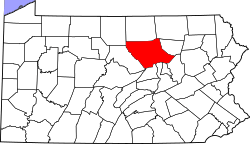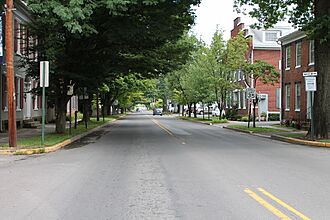Muncy, Pennsylvania facts for kids
Quick facts for kids
Muncy, Pennsylvania
|
||
|---|---|---|
|
Borough
|
||

Downtown Muncy
|
||
|
||

Location of Muncy in Lycoming County, Pennsylvania
|
||

Map of Pennsylvania highlighting Lycoming County
|
||
| Country | United States | |
| State | Pennsylvania | |
| County | Lycoming | |
| Settled | 1797 | |
| Incorporated | 1826 | |
| Area | ||
| • Total | 0.84 sq mi (2.19 km2) | |
| • Land | 0.84 sq mi (2.19 km2) | |
| • Water | 0.00 sq mi (0.00 km2) | |
| Elevation | 499 ft (152 m) | |
| Population
(2020)
|
||
| • Total | 2,440 | |
| • Density | 2,891.00/sq mi (1,116.38/km2) | |
| Time zone | UTC-5 (Eastern (EST)) | |
| • Summer (DST) | UTC-4 (EDT) | |
| ZIP Code |
17756
|
|
| Area code(s) | 570 | |
| FIPS code | 42-52264 | |
| GNIS feature ID | 1213993 | |
Muncy is a small town, called a borough, in Lycoming County, Pennsylvania, United States. The name Muncy comes from the Munsee Native Americans. They once lived in this area. In 2020, about 2,442 people lived here. Muncy is part of the Williamsport, Pennsylvania, Metropolitan area. It is located on the West Branch Susquehanna River. This is just south of where Muncy Creek joins the river. The current mayor is Jon Ort.
Contents
History of Muncy
Early Settlers
Around 1787, four brothers named Silas, William, Benjamin, and Isaac McCarty came to this area. They were Quakers from Bucks County. William and Benjamin bought a large piece of land. It was about 300 acres (1.2 km²). This land was known as the "John Brady farm."
John Brady was one of the first settlers here. He received land for serving in the Bouquet Expedition. He chose land near what is now Muncy. In 1776, he built a private fort on his land. He called it "Fort Brady." John Brady's house was very big for its time. He built a strong log wall around it for protection.
The Brady home was close to the edge of the frontier. The Susquehanna River was nearby. Native American tribes lived on the other side of the river. They often crossed the river to raid settler homes. Settlers also crossed the river to chase the raiding parties. This led to many conflicts. Major John Brady chose to settle his family in this dangerous area. This greatly affected his sons, Samuel Brady and Hugh Brady. Hugh Brady later became a Major General in the United States Army.
The McCarty brothers divided the old Brady land. William took the northern part. Benjamin took the southern part. Main Street now marks the old boundary.
In 1797, Benjamin McCarty decided to start a town. He began selling lots on what is now Main Street. His brother William and Isaac Walton also sold land. The town was first named Pennsborough. This was to honor William Penn.
19th Century Growth
The town grew slowly at first. For many years, it was just a small village. In 1826, it officially became a borough. This happened on March 15, 1826.
On January 19, 1827, the town's name changed. It went from Pennsborough to Muncy. People thought "Pennsborough" was too long. The new name honored the Monseys tribe. They were a group of Lenape Native Americans who first lived there.
Muncy Abolition Riot of 1842
Many people think all northerners were against slavery before the Civil War. But this is not true. Some people in northern states like Pennsylvania supported slavery. However, there were also many abolitionists. These were people who wanted to end slavery.
Enos Hawley was a Quaker from Muncy. He was a strong abolitionist. In April 1842, he invited a speaker to Muncy. This speaker was against slavery. The speech caused a big riot.
The speaker gave his talk at a school in Muncy. Eighteen men gathered outside. They threw rocks at the school. All the windows broke. Enos Hawley and the speaker were hurt. When they left the school, the rioters threw eggs at them. The rioters followed them to Hawley's home. They attacked his house until after midnight. Local police then stopped the riot. They arrested the rioters.
The rioters went to trial in October. Thirteen of the eighteen men were found guilty. A jury member named Abraham Updegraff helped convict them. Updegraff was an abolitionist. He was also part of the Underground Railroad in Lycoming County. He convinced the other jurors to find the men guilty.
However, Pennsylvania Governor David R. Porter later pardoned the rioters. This meant they were forgiven. Governor Porter said the speech was "offensive" and caused the riot. Because of this, Governor Porter was nicknamed "Previous Pardonin Porter." Historians believe he pardoned them due to political pressure. This was a time when the issue of slavery caused many disagreements.
21st Century Muncy
Today, Muncy has about 2,700 people. The high school football team has a special rivalry. They play the Montgomery high school team every year for "The Shoe." This trophy was made in 1961. It came from an old athletic shoe found in the Muncy High School locker room. The shoe is now bronzed and on a wooden box. Muncy has won this game 28 times, while Montgomery has won 18 times. Muncy also has a rivalry with Hughesville's team.
The Muncy Historic District was added to the National Register of Historic Places in 1980. This means it's a special place with important history.
Geography
Muncy is located at 41°12′7″N 76°47′11″W / 41.20194°N 76.78639°W. It is about 130 miles (209 km) northwest of Philadelphia. It is also about 165 miles (266 km) east-northeast of Pittsburgh. Muncy is surrounded by Muncy Creek Township.
The town covers about 0.8 square miles (2.1 km²). All of this area is land. Muncy has a hot-summer humid continental climate. This means it has warm summers and cold winters. Average monthly temperatures range from 26.8 °F (-2.9 °C) in January to 72.3 °F (22.4 °C) in July. The hardiness zone for plants is 6b.
Population Data
| Historical population | |||
|---|---|---|---|
| Census | Pop. | %± | |
| 1850 | 901 | — | |
| 1860 | 1,010 | 12.1% | |
| 1870 | 1,040 | 3.0% | |
| 1880 | 1,174 | 12.9% | |
| 1890 | 1,295 | 10.3% | |
| 1900 | 1,934 | 49.3% | |
| 1910 | 1,904 | −1.6% | |
| 1920 | 2,054 | 7.9% | |
| 1930 | 2,413 | 17.5% | |
| 1940 | 2,606 | 8.0% | |
| 1950 | 2,756 | 5.8% | |
| 1960 | 2,830 | 2.7% | |
| 1970 | 2,872 | 1.5% | |
| 1980 | 2,700 | −6.0% | |
| 1990 | 2,702 | 0.1% | |
| 2000 | 2,663 | −1.4% | |
| 2010 | 2,477 | −7.0% | |
| 2020 | 2,442 | −1.4% | |
| 2021 (est.) | 2,425 | −2.1% | |
| Sources: | |||
In 2000, there were 2,663 people living in Muncy. There were 1,142 households and 749 families. The population density was about 3,174 people per square mile (1,225 per km²). Most residents, about 98.46%, were White.
About 28.3% of households had children under 18. About 52.8% were married couples. The average household had 2.33 people. The average family had 2.86 people.
The population was spread out by age. About 23.5% were under 18. About 17.3% were 65 or older. The average age was 39 years. For every 100 females, there were about 90.2 males.
The median income for a household was $33,603. For a family, it was $38,934. About 10.0% of the population lived below the poverty line. This included 19.0% of those under 18.
Notable People
- Anna Morris Holstein (1824-1901), a founder of organizations, Civil War nurse, and author.
- Ed Ott, (1951-2024), a former Major League Baseball player.
See also
 In Spanish: Muncy para niños
In Spanish: Muncy para niños





